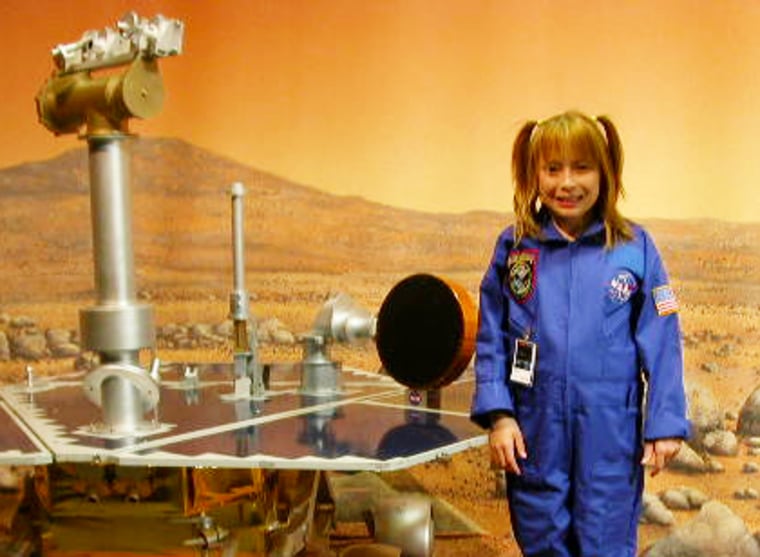NASA's Spirit rover rolled off its landing platform and onto the surface of Mars early Thursday, placing its six wheels on solid ground for the first time since the unmanned robot bounced down on the Red Planet nearly two weeks ago.
"Mars now is our sandbox," said Charles Elachi, director of NASA's Jet Propulsion Laboratory. "We are ready to play and learn."
Pictures beamed from Spirit showed the now-abandoned lander with tire tracks leading away from it.
The rollout had been delayed for a couple of days because Spirit's primary path off the platform was blocked by partially deflated airbags — the airbags that cushioned the spacecraft's bouncing touchdown in Gusev Crater on Jan. 3. Engineers had to have the rover turn 115 degrees on its 16-inch-high (40-centimeter-high) platform to set the stage for Thursday's roll down a secondary ramp, which they considered the mission's riskiest maneuver.
The team at JPL sent the order to Spirit to get moving at around 3:21 a.m. ET, playing the theme from "Rawhide" ("Rolling, rolling, rolling ...") to get in the mood. Less than two hours later, the rover sent confirmation it had sucessfully maneuvered down the ramp and onto the Martian soil.
“This is a big relief. We are on Mars. Spirit has landed,” said Rob Manning, manager of the entry, descent and landing portion of the mission. “Our wheels are finally dirty.”
As new images streamed across the screens at JPL, the group of engineers and scientists cheered and hugged each other.
The song "Who Let the Dogs Out" played over speakers, and project manager Peter Theisinger showed off a T-shirt with an image of the rover and text that said "My other car is on Mars."
Jennifer Trosper, mission manager for surface operations, opened a celebratory bottle of champagne at a news conference held about an hour later.
“Now we are the mission that we all envisioned three and a half years ago,” she said.
Elachi noted President Bush’s call on Wednesday for moon missions and long-term robotic and human journeys to Mars.
“We at NASA, we move awfully fast,” Elachi joked. “In less than 15 hours, we are doing our first step.”
Spirit's next steps
The golf cart-sized Spirit hasn't gone far: The rover traveled only about 10 feet (3 meters) away from its lander. Mission plans call for Spirit to spend three to four days parked beside its landing platform after rolling off, giving it time to find its bearings and perform some preliminary analysis of the soil and pebbles around it.
On Friday, Spirit should deploy its robotic arm and take its first photographs with its microscopic imager, said Steven Squyres of Cornell University, the mission’s main scientist.
NASA then planned for Spirit to begin a meandering trip in the direction of an impact crater about 825 feet (250 meters) away. Spirit was designed to travel dozens of yards a day.
On its way, scientists said Spirit would prospect for geologic evidence that the now-dry Red Planet was once wetter and hospitable to life. Scientists suspect that Spirit's landing site in the middle of 95-mile-wide (150-kilometer-wide) Gusev Crater may have been a lakebed in the planet's ancient past.

One of two rocks, dubbed “Adirondack” and “Sashimi,” both about 5 yards (meters) from the rover, is expected to be Spirit’s first target. The rover then might visit a shallow depression if there is enough time before its twin, Opportunity, lands Jan. 24 on the opposite side of the planet. NASA wants to park Spirit for the three days immediately following Opportunity’s arrival so scientists in the $820 million double mission can focus on Opportunity.
NASA then plans for Spirit to begin a meandering trip in the direction of an impact crater about 825 feet (250 meters) away.
Spirit already has sent back stunning, three-dimensional, color photographs of Mars revealing the planet’s terrain in vivid, unprecedented detail. Now that the rover is on the ground, science will be at center stage during the remainder of the mission, scheduled to last at least 90 days.
"We're ready to hand over the keys" to the science team, flight director Chris Lewicki said Thursday, jokingly comparing his part of the mission to a valet who brings the car around.
Later on Thursday, JPL controllers planned to aim an instrument called a mini-thermal emission spectrometer, or Mini-TES, upward to obtain a reading of infrared radiation emitted by particles in the Martian sky at the time the European orbiter Mars Express snaps the same type of images from 186 miles (300 kilometers) overhead.
The simultaneous images of the Martian sky from opposite vantage points would provide scientists with newly detailed data about the composition of the planet’s atmosphere, deputy project scientist Albert Haldemann said.
Mars Express is conducting its own survey of the Red Planet's surface and atmosphere. It was also designed to communicate with Europe's Mars lander, the British-built Beagle 2, which arrived on Christmas Day. Efforts to communicate with Beagle have so far been unsuccessful, however, and scientists fear that the probe is irretrievably lost.
